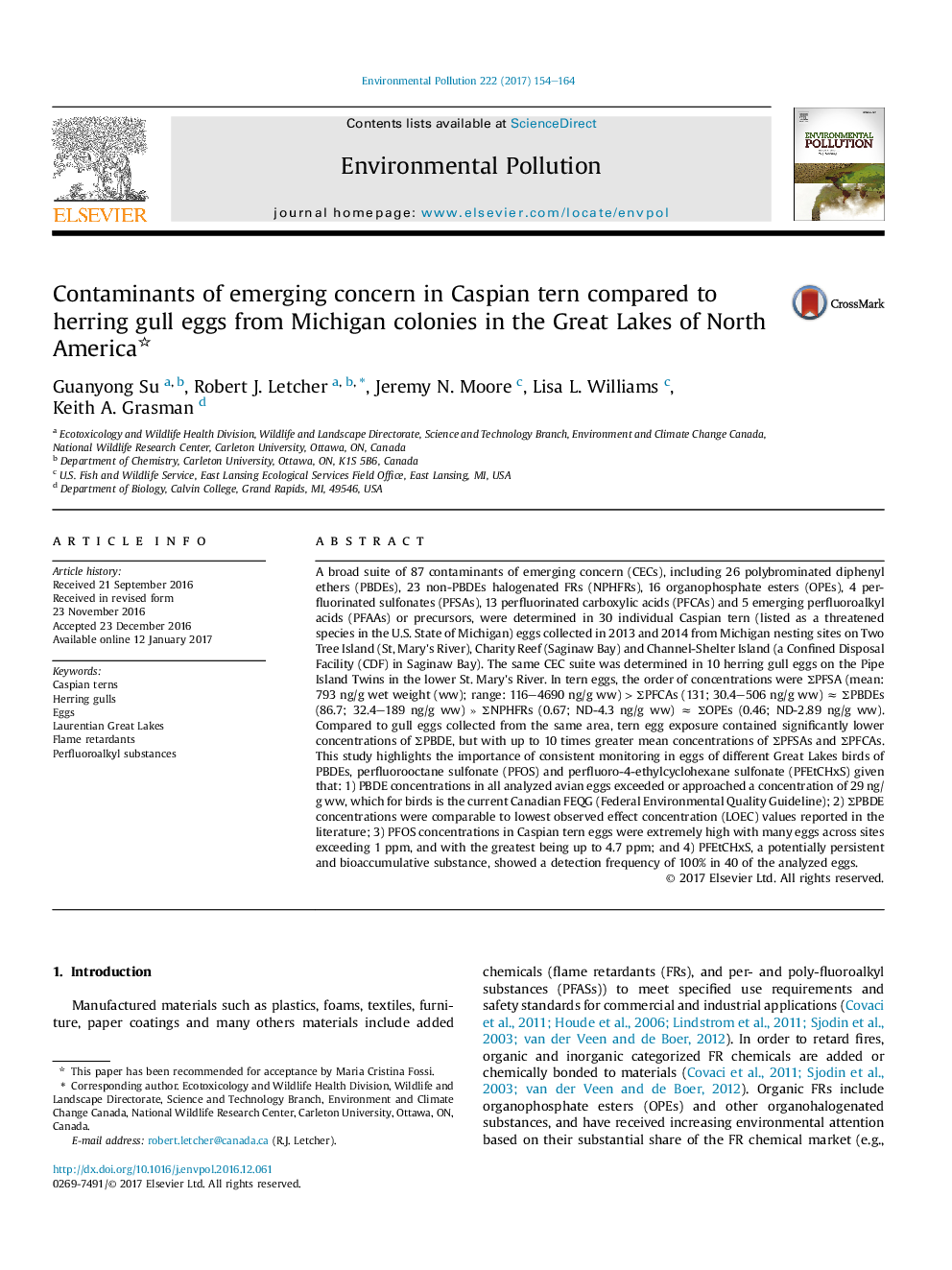| کد مقاله | کد نشریه | سال انتشار | مقاله انگلیسی | نسخه تمام متن |
|---|---|---|---|---|
| 5749007 | 1619151 | 2017 | 11 صفحه PDF | دانلود رایگان |

- Eighty-seven contaminants of emerging concern were analyzed in Great Lakes Caspian tern eggs.
- Order of concentrations in tern eggs was ΣPFSAs > ΣPFCAs â ΣPBDEs » ΣNPHFRs â ΣOPEs.
- Tern eggs contained significantly greater PFAS but lower FR levels as compared to gull eggs.
- Tern eggs contained extremely high concentrations of PFOS with the greatest being up to 4.7Â ppm.
- The new PFSA, PFEtCHxS, showed a detection frequency of 100% in all analyzed eggs.
A broad suite of 87 contaminants of emerging concern (CECs), including 26 polybrominated diphenyl ethers (PBDEs), 23 non-PBDEs halogenated FRs (NPHFRs), 16 organophosphate esters (OPEs), 4 perfluorinated sulfonates (PFSAs), 13 perfluorinated carboxylic acids (PFCAs) and 5 emerging perfluoroalkyl acids (PFAAs) or precursors, were determined in 30 individual Caspian tern (listed as a threatened species in the U.S. State of Michigan) eggs collected in 2013 and 2014 from Michigan nesting sites on Two Tree Island (St, Mary's River), Charity Reef (Saginaw Bay) and Channel-Shelter Island (a Confined Disposal Facility (CDF) in Saginaw Bay). The same CEC suite was determined in 10 herring gull eggs on the Pipe Island Twins in the lower St. Mary's River. In tern eggs, the order of concentrations were ΣPFSA (mean: 793 ng/g wet weight (ww); range: 116-4690 ng/g ww) > ΣPFCAs (131; 30.4-506 ng/g ww) â ΣPBDEs (86.7; 32.4-189 ng/g ww) » ΣNPHFRs (0.67; ND-4.3 ng/g ww) â ΣOPEs (0.46; ND-2.89 ng/g ww). Compared to gull eggs collected from the same area, tern egg exposure contained significantly lower concentrations of ΣPBDE, but with up to 10 times greater mean concentrations of ΣPFSAs and ΣPFCAs. This study highlights the importance of consistent monitoring in eggs of different Great Lakes birds of PBDEs, perfluorooctane sulfonate (PFOS) and perfluoro-4-ethylcyclohexane sulfonate (PFEtCHxS) given that: 1) PBDE concentrations in all analyzed avian eggs exceeded or approached a concentration of 29 ng/g ww, which for birds is the current Canadian FEQG (Federal Environmental Quality Guideline); 2) ΣPBDE concentrations were comparable to lowest observed effect concentration (LOEC) values reported in the literature; 3) PFOS concentrations in Caspian tern eggs were extremely high with many eggs across sites exceeding 1 ppm, and with the greatest being up to 4.7 ppm; and 4) PFEtCHxS, a potentially persistent and bioaccumulative substance, showed a detection frequency of 100% in 40 of the analyzed eggs.
169
Journal: Environmental Pollution - Volume 222, March 2017, Pages 154-164